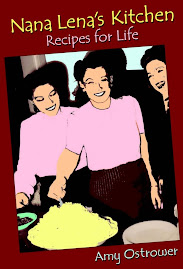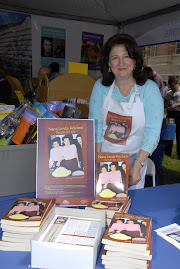(For those who are just joining this story in progress, page down to read Part 1 before continuing with Part 2.)The next morning, I joined my mother and my father’s mother, Bubbie Sareva, and my Tante Fannie, my father’s sister, in my grandmother’s kitchen, in the making of gefilte fish, a family recipe handed down from generation to generation. This time it was my turn to learn.
Bubbie Sareva inspected my hands and nails. She sat me down in front of a mound of onions and barked orders at me. “Peel them, and then cut them in quarters. Save the skins for the broth.”
I began peeling onions while she and Tante Fannie went out back and separated Poor Fish from his head. As I chopped and peeled the onions, tears pouring down my face, I decided that if Poor Fish had to die for our meal, then I was determined that the least I could do was to make this the best gefilte fish ever. I would make Poor Fish proud. So I continued chopping the onions and crying my eyes out. Some of my tears must have ended up in the recipe.
At the other end of the kitchen, Bubbie and Tante Fannie skinned and de-boned the fish, while Mama prepared a pot of boiling water, to which she added one stalk of celery, three onions with their skins separated, parsnips, carrots, and the fish head.
While this broth simmered on the stove, the women cleaned the rest of the fish and set up the grinder, inserting alternating pieces of fish, celery, and onions.
“In Galicia they use the sugar in the broth.” Bubbie Sareva bent over the pot and skimmed off some foam.
“Tante Gussie sometimes used the beets, remember, Mama?” Tante Fannie said.
“Not in my kitchen.” Bubbie Sareva nodded her approval of the broth to Minnie. “So tell me, what happened to our Goldele? Is it a bad cut?”
Minnie shook her head. “I think she did it on purpose.”
“No.”
“She wouldn’t.”
“She hates the smell.”
“Can you blame her?”
All three women made a face.
“We may not like how it smells, but we like how it tastes.” Bubbie Sareva looked over at Lena, who beamed happily even though her face was streaked with tears. “What’s done is done, and why Goldele chose not to join us is Goldele’s problem. But this little one….”
“My Lena.” Minnie beamed proudly.
Bubbie Sareva nodded her head, “She likes the kitchen. She is at home here.” She waved to her granddaughter, “Come, Lena, let me show you how we make the fish.”
Mama removed the fish head and strained the broth, which had now reached a beautiful golden-brown color. Lena watched intently as Tante Fannie handed her mother each of the items she mentioned.
“Now we add the eggs, a half an eggshell of salt, a bisele, just a little white pepper, not the brown, and a yahrzeit glass of matzo meal. Mix it together good, like this. Use a little more matzo meal if it’s too runny. Let me see the hands. Are they clean?”
I nodded eagerly, waving them in front of her.
“Now wet your hands and take a handful of this and rub it into a ball, and then we drop it into the boiling broth like this!”
“Be careful when you drop it, so you don’t splash and burn yourself.” Tante Fannie warned me, as she gently tied my hair back, out of my face: Tante Fannie, whose hands always smelled like vanilla.
I pushed my sleeves up and dipped my hands into the mixture. It’s cold and slimy, like a mud pie. I made a ball and dropped it gently into the water.
“Perfect. Her hands are just the right size.”
I made another and dropped it in a little less gently. I made dozens of balls, dropping them in one after the other, until all of the mixture was gone, and dozens of little balls, about two inches in diameter, started bubbling to the surface of our witches’ brew.
“Like I said, she’s a natural.” Bubbie Sareva patted her granddaughter’s head. “In the old days, after the fish cooked, we used to wrap the balls in the fish skin and that’s why we called it gefilte fish, because we filled the fish.” She flashed her daughter and daughter-in-law a look. “Now we are in America. We don’t need such a thick skin.”
“Mama, if you want to keep the skin, we can keep it….”
“Your Tante Fannie wants to be a modern woman.”
“Mother, if it really bothers you….”
Mama led me to the sink so that I could wash my hands. Then she squeezed lemon over them.
“Come, Lena, now is the best part.“
“What, Bubbie?”
“Now we sit and drink a glassl tea with a touch of schnaps.”
“But, Mama, she’s only a child.”
“She can make the fish, she can have the tea. She earned it.”
They all nodded and patted me on the back. I earned it. And you know what was the best part? It was the best gefilte fish ever. I made Poor Fish proud.
Stay tuned for Part 3 tomorrow...





